What Does Lung Cancer Look Like on an X-ray?
- Updated on: Jun 26, 2024
- 3 min Read
- Published on Apr 20, 2021


Lung cancer chest Xray films
If your doctor suspects you having lung cancer based on the results of a screening test or because of the symptoms you might experience, he or she will ask for tests and exams to confirm its presence.
Chest X-ray is often the first test your doctor will do if you experience symptoms that match the signs of lung cancer. X-rays of your chest can be done at imaging centers, hospitals, or even in some doctors’ settings. Sometimes, your doctor may ask for more tests if the X-ray does not clarify completely.
What does lung cancer look like on an x ray?
Chest x-rays are generally difficult to read. Chest x-rays do not have fixed marks telling you that the object is certainly present somewhere in the image. Reading of the chest x-rays, particularly for those people who do not have clear symptoms for the lung cancer, is even more difficult.
The chances are that an object (such as a tumor) is not visible and will never be found in the X-ray films.
Sometimes, the cancer may appear as a large rounded mass filling in the lung. Whenever there is an abnormal area of shadowing (indicative of increased density/whiteness) in the lungs, the diagnosis of infection or cancer is considered as the likely cause.
The presence of a pleural effusion also does not help in identifying whether an area of abnormal shadowing is due to infection or cancer as both can cause effusions.
Sometimes, an area of air-space shadowing may be noted. This can also be due to either infection or cancer. The X-ray cannot differentiate between the two.
But it is generally the clinical information which determines the diagnosis rather than the chest X-ray.
Is a Chest X-Ray enough to diagnose the lung cancer?
The answer to this question is a clear ‘No’. Though it is important to get an X-ray bit it does not provide a clear picture of what causes the problem. If you have symptoms of lung cancer or if you are at high risk for lung cancer, a chest x-ray cannot completely eliminate the chances that you have lung cancer.
When do X-rays miss the lung cancer: Missed diagnoses
There are high chances of a missed diagnosis. One of the most frequent causes of a missed diagnosis of the lung cancer in an X ray is that a radiologist is generally not able to compare new films to the previously taken films. If it could be made possible, multiple illustrations present at the same time can allow the radiologist to compare them which can lower the risk of missing a cancer.
There are certain situations in which a tumor can be missed on a chest x-ray. Situations include such as:
- Cancers in certain parts of the lungs are more difficult to be visualized and are more likely to be missed.
- Dense structures such as bone can hide small cancers.
- Cancers in the periphery of the lungs (such as lung adenocarcinoma) are relatively easily missed than those that occur centrally near the large airways (such as small cell lung cancer and squamous cell carcinoma of the lungs).
- Tumors that are smaller than 1.5 centimeters are more easily missed than larger cancers.
- Tumors that have a “ground glass appearance” are likely to remain unseen.
Can your doctor use chest X-Rays to screen for lung cancer?
As discussed above, chest x-rays aren’t enough to rule out the lung cancer for those who have symptoms. They are not effective in screening for lung cancer too.
Some doctors may still want to get chest x-rays done for people who are at high risk, but one should to understand that x-rays cannot differentiate clearly among several conditions such as from the infection of lung etc.
What can you do to avoid a misdiagnosis or missed diagnosis of lung cancer?
The experience of a missed diagnosis of lung cancer on a chest X-ray can be quite frightening. There are ways you can consider to decrease the risk of missed diagnosis.
CT screening can decrease the risk of death from lung cancer among those who have risk factors. But note that even a CT scan can miss some lung cancers. Testing may further be needed even after a CT scan is done.
Make sure you disclose your past X-ray films to your doctor if you have any. This will help in comparison of the states. Ignoring to compare new chest x-rays to an old one is the major cause of missed diagnoses.












